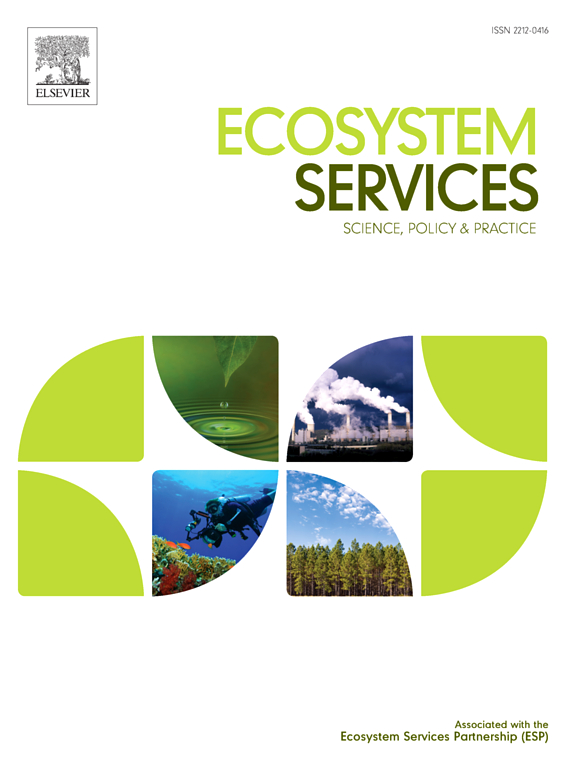哥伦比亚亚马逊地区每年森林损失的经济价值
IF 6.6
2区 环境科学与生态学
Q1 ECOLOGY
引用次数: 0
摘要
自1985年以来,哥伦比亚亚马逊地区的热带森林砍伐已导致300多万公顷森林的损失,严重影响了对当地社区和全球气候调节至关重要的生态系统服务。本研究采用总经济价值框架来估算与森林砍伐相关的年度经济损失,重点关注六个关键ES:碳储量;提供野生动物和渔业资源;木柴供应;非用材林产品;以及药用植物的本土知识。在方法上,我们将生物资源的多样性、丰度和利用的生物物理评估与基于市场和基于成本的评估技术相结合。利用森林清查图数据和国际市场的碳定价对碳储存损失进行量化。供应服务(动物群、鱼类、柴火和非木材产品)的价值是根据当地消费数据和区域市场价格计算的。土著医学知识的文化价值是根据民族植物学数据库和关于常见病治疗模式和人口分布的官方普查统计数字估计的。在公顷水平上的空间外推可以汇总整个毁林地区的ES值。我们的研究结果表明,每年的ES损失至少在2.54亿美元至4亿美元之间,相当于哥伦比亚GDP的0.06%至0.11%。通过明确地将生态数据与经济指标联系起来,这项研究为旨在阻止森林砍伐和保护亚马逊多功能利益的决策提供了坚实的基础。本文章由计算机程序翻译,如有差异,请以英文原文为准。
The economic value of annual forest loss in the Colombian Amazon
Tropical deforestation in the Colombian Amazon has led to the loss of over 3 million hectares of forest since 1985, severely affecting ecosystem services (ES) vital to local communities and global climate regulation. This study applies a Total Economic Value framework to estimate the annual economic loss associated with deforestation, focusing on six key ES: carbon storage; provision of wildlife and fishery resources; firewood supply; non-timber forest products; and indigenous knowledge of medicinal plants. Methodologically, we integrate biophysical assessments on the diversity, abundance, and use of biological resources with market-based and cost-based valuation techniques. Carbon storage loss is quantified using forest inventory plot data and carbon pricing from international markets. Provisioning services (fauna, fish, firewood, and non-timber products) are valued using local consumption data and regional market prices. The cultural value of indigenous medicinal knowledge is estimated based on ethnobotanical databases and official census statistics on treatment patterns for common illnesses and population distribution. Spatial extrapolation at the hectare level enables the aggregation of ES values across deforested areas. Our results indicate that annual ES losses range from at least US$254 million to US$400 million, equivalent to 0.06–0.11% of Colombia's GDP. By explicitly linking ecological data with economic metrics, this study provides a robust basis for decision-making aimed at halting deforestation and safeguarding the Amazon’s multifunctional benefits.
求助全文
通过发布文献求助,成功后即可免费获取论文全文。
去求助
来源期刊

Ecosystem Services
ECOLOGYENVIRONMENTAL SCIENCES&-ENVIRONMENTAL SCIENCES
CiteScore
14.90
自引率
7.90%
发文量
109
期刊介绍:
Ecosystem Services is an international, interdisciplinary journal that is associated with the Ecosystem Services Partnership (ESP). The journal is dedicated to exploring the science, policy, and practice related to ecosystem services, which are the various ways in which ecosystems contribute to human well-being, both directly and indirectly.
Ecosystem Services contributes to the broader goal of ensuring that the benefits of ecosystems are recognized, valued, and sustainably managed for the well-being of current and future generations. The journal serves as a platform for scholars, practitioners, policymakers, and other stakeholders to share their findings and insights, fostering collaboration and innovation in the field of ecosystem services.
 求助内容:
求助内容: 应助结果提醒方式:
应助结果提醒方式:


